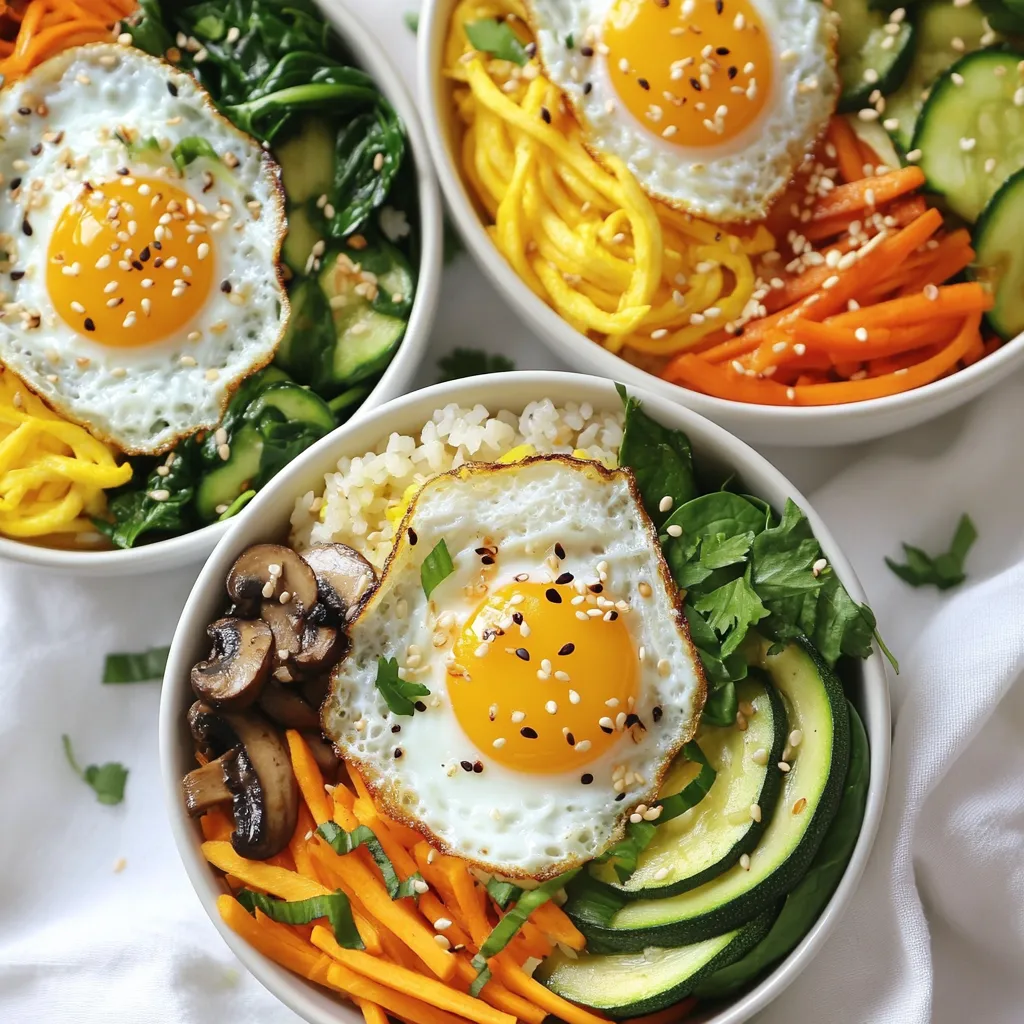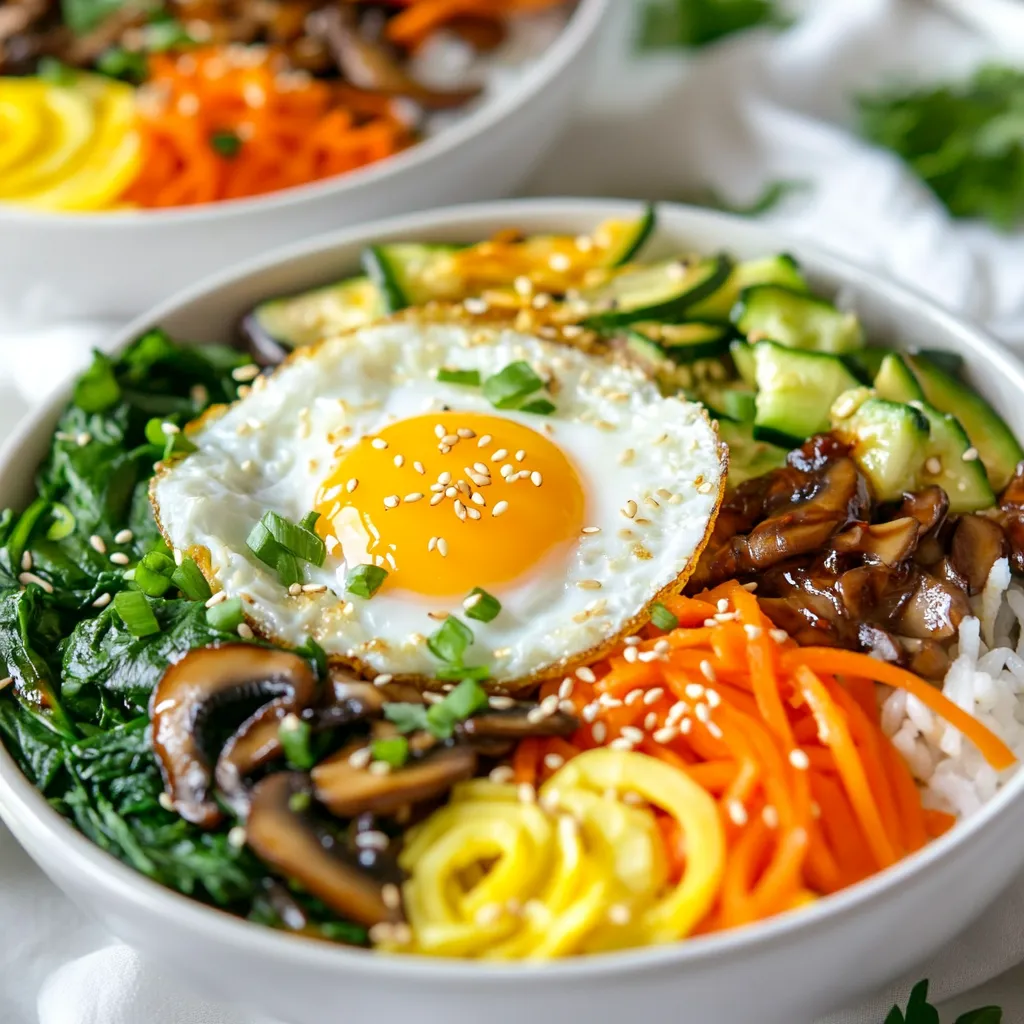WANT TO SAVE THIS RECIPE?
Are you ready to bring a burst of flavor to your kitchen? Today, I’ll show you how to make Korean Bibimbap Bowls that are easy and delicious. This colorful dish mixes tender rice, fresh veggies, and a perfect fried egg, all topped with a spicy sauce. Whether you’re cooking for yourself or impressing friends, this recipe will be a hit. Let’s dive into this fun, tasty journey!

Why I Love This Recipe
- Vibrant Colors: This dish is a feast for the eyes with its array of colorful vegetables that make every bowl look appealing.
- Balanced Nutrition: With a mix of vegetables, protein from eggs, and wholesome rice, it offers a nutritious and well-rounded meal.
- Customizable: You can easily modify the ingredients based on your preferences or what you have on hand, making it versatile.
- Quick to Prepare: In just 40 minutes, you can whip up this delicious meal, ideal for busy weeknights.
Ingredients
Key Ingredients for Korean Bibimbap
For a great bibimbap, you need specific items. Here are the must-haves:
– 1 cup cooked jasmine rice
– 1 cup spinach, blanched and squeezed dry
– 1 medium carrot, julienned
– 1 cup shiitake mushrooms, sliced
– 1 small zucchini, julienned
– 2 eggs
– 1 tablespoon sesame oil
– 2 tablespoons gochujang (Korean chili paste)
– 1 tablespoon soy sauce
– 1 teaspoon sesame seeds
– Salt to taste
– Fresh cilantro for garnish
Each ingredient adds flavor and texture. The rice is the base. Spinach gives color and nutrients. Carrots and zucchini bring crunch. Shiitake mushrooms add a rich umami taste.
Cooking Essentials
You will need a few tools to make your bibimbap. Here’s what I recommend:
– A medium-sized pot for cooking rice
– A non-stick skillet for cooking eggs
– A frying pan for sautéing vegetables
– A cutting board and knife for chopping
These tools help you prepare everything easily. They make cooking fun and quick.
Optional Garnishes
You can add extra toppings to make your bibimbap special. Here are some ideas:
– Sliced green onions
– Toasted seaweed strips
– Kimchi for a spicy kick
– Extra sesame seeds for crunch
These garnishes add even more flavor. Feel free to mix and match based on your taste!

Step-by-Step Instructions
Preparing the Rice
To start, cook 1 cup of jasmine rice. Follow the package instructions for best results. Once the rice is done, set it aside and keep it warm. Warm rice will help melt the flavors together later.
Sautéing the Vegetables
Next, heat a pan over medium heat and add half of the sesame oil. Sauté the sliced shiitake mushrooms until they are tender. Season them with a pinch of salt. Once done, take them out and set them aside. In the same pan, add the rest of the sesame oil. Sauté the julienned carrots and zucchini until they are just tender. Add the blanched spinach last to warm it quickly. Combine all your sautéed vegetables in a bowl.
Cooking the Eggs
Now it’s time for the eggs. In a non-stick skillet, fry the eggs sunny-side up. Cook them until the whites are set, but the yolks should still be runny. This adds a creamy texture to your bibimbap.
Assembling the Bibimbap Bowls
For assembly, divide the cooked rice into bowls. Top each bowl with portions of your sautéed vegetables. Make a small well in the center of the rice for the fried egg. This helps keep everything neat and organized.
Adding the Sauce
Finally, drizzle gochujang and soy sauce over the assembled bowls. You can adjust the amount based on your spice preference. Sprinkle sesame seeds on top for a nice crunch. This adds flavor and texture to your dish.
Tips & Tricks
Best Practices for Cooking Rice
To cook perfect jasmine rice, rinse it first. This removes excess starch. Use a pot with a tight lid. The ratio is 1 cup rice to 1.5 cups water. Bring it to a boil, then lower the heat. Let it simmer for 15 minutes. Turn off the heat and let it sit covered for 10 minutes. Fluff the rice with a fork before serving.
How to Perfectly Sauté Vegetables
Use medium heat to sauté vegetables. Start with shiitake mushrooms for flavor. Sauté them in half the sesame oil. Cook them until they are soft. For carrots and zucchini, add them next. Cook just until tender. Add spinach last to keep it bright green. Mix all the veggies together before serving.
Tricks for a Flawless Fried Egg
Use a non-stick skillet for easy frying. Heat the pan over low heat. Add a tiny bit of oil to prevent sticking. Crack the eggs gently into the pan. Cook until the whites are set, but the yolk is runny. This will add a rich flavor to your bibimbap.
Presentation Tips for a Stunning Dish
To make your bibimbap look great, use a shallow bowl. Start with a base of rice in the center. Arrange the vegetables around the rice. Create a spot for the fried egg in the middle. Drizzle gochujang and soy sauce on top. Finish with sesame seeds and fresh cilantro for color. This will make your meal look as good as it tastes!
Pro Tips
- Fresh Ingredients: Use fresh, seasonal vegetables for the best flavor and vibrant colors in your bibimbap.
- Perfect Egg: For a runny yolk, cook the eggs on low heat, and cover the skillet to help the whites set evenly.
- Custom Heat: Adjust the amount of gochujang to suit your spice preference; start with less and add more if you like it spicy.
- Rice Texture: For a chewier texture, try using short-grain rice instead of jasmine rice; it holds the toppings well.

Variations
Vegetarian Version
You can easily make a vegetarian bibimbap. Simply skip the eggs or use tofu instead. For a tasty twist, add more veggies like bell peppers or radishes. Try including kimchi for an extra kick. This version is colorful and packed with nutrients.
Vegan Bibimbap Options
To make a vegan bibimbap, replace the eggs with avocado slices. You can also use silken tofu for creaminess. Use vegetable broth to steam your veggies for more flavor. Remember, gochujang is usually vegan, but always check the label. This way, you can enjoy a hearty meal without animal products.
Protein Alternatives (Chicken, Beef, Tofu)
If you like meat, chicken or beef works great. For chicken, grill or sauté it with soy sauce and sesame oil. For beef, use thin strips and cook them until tender. If you want a plant-based protein, tofu is perfect. Just sauté it until golden brown. Each option adds a unique taste to your bibimbap.
Storage Info
How to Store Leftover Bibimbap
To store leftover bibimbap, let it cool first. Place the rice and veggies in separate airtight containers. This keeps them fresh. You can combine everything when ready to eat. Store the eggs in a separate container to keep them from getting soggy. Bibimbap lasts in the fridge for about three days.
Reheating Tips
Reheat bibimbap in a pan over low heat. Add a splash of water to keep it moist. Stir gently to warm it through. If you want the egg warm, heat it separately. You can also microwave it. Cover the bowl with a damp paper towel while reheating. This helps keep the steam in.
Meal Prep Ideas for Korean Bibimbap
Meal prep for bibimbap is fun and easy. Cook a big batch of jasmine rice at once. You can also sauté all the veggies ahead of time. Store them in small containers. When you are ready to eat, just combine everything in a bowl. Add the sauce and a fresh egg for a quick meal. This way, you enjoy healthy and tasty bibimbap all week long!
FAQs
What is Bibimbap?
Bibimbap is a Korean rice bowl. It mixes rice with various veggies and toppings. The word “bibimbap” means mixed rice. You can find it colorful and tasty. It often includes a fried egg on top. The dish is served with spicy gochujang sauce. You can enjoy it warm and fresh.
Can I use different vegetables?
Yes, you can use many types of vegetables. Bibimbap is flexible and adaptable. Try bell peppers, cucumbers, or bean sprouts. You can even use leftover veggies from your fridge. The key is to have a mix of colors and textures. This makes the dish fun and vibrant.
How do I make Bibimbap spicy?
To make Bibimbap spicy, add more gochujang. Start with one tablespoon and taste it. If you want more heat, add more to your liking. You can also add sliced fresh chilies. Another option is to mix in some chili oil. Adjust the spice level to suit your taste.
Where can I find authentic Bibimbap restaurants?
You can find authentic Bibimbap at Korean restaurants. Look for places that focus on traditional dishes. Check reviews online for recommendations. Many cities have Korean neighborhoods with several options. You can also ask friends for their favorite spots. Enjoy the experience of trying Bibimbap made by experts.
Korean Bibimbap combines simple ingredients into a delicious meal. We explored key ingredients and essential cooking steps. You learned how to prepare rice, sauté veggies, and cook eggs. Tips on presentation and variations help you create your unique dish. Don’t forget about storage for leftovers or meal prep. Enjoy trying different tastes and finding your perfect Bibimbap balance. Dive in and make this dish your ow
Colorful Korean Bibimbap Bowls
A vibrant and nutritious Korean dish featuring a variety of sautéed vegetables, rice, and a fried egg, served with spicy gochujang sauce.
Prep Time 20 minutes mins
Cook Time 20 minutes mins
Total Time 40 minutes mins
Course Main Course
Cuisine Korean
Servings 2
Calories 500 kcal
- 1 cup cooked jasmine rice
- 1 cup spinach, blanched and squeezed dry
- 1 medium carrot, julienned
- 1 cup shiitake mushrooms, sliced
- 1 small zucchini, julienned
- 2 eggs
- 1 tablespoon sesame oil
- 2 tablespoons gochujang (Korean chili paste)
- 1 tablespoon soy sauce
- 1 teaspoon sesame seeds
- None Salt to taste
- None Fresh cilantro for garnish
Prepare the Rice: Start by cooking jasmine rice according to package instructions. Once cooked, set aside and keep warm.
Sauté the Vegetables: In a pan over medium heat, add half the sesame oil. Sauté the shiitake mushrooms until tender and season with a pinch of salt. Remove from the pan and set aside. In the same pan, add the remaining sesame oil and sauté the julienned carrot and zucchini until just tender. Add the blanched spinach at the last minute to warm it through, then combine all sautéed vegetables in a bowl.
Cook the Eggs: In a non-stick skillet, fry the eggs sunny-side up until the whites are set but the yolk remains runny.
Assemble the Bowls: Divide the cooked rice among bowls, placing a portion of each sautéed vegetable on top. Create a small well at the center for the fried egg.
Add the Sauce: Drizzle gochujang and soy sauce over the assembled bowl. Sprinkle sesame seeds on top.
Garnish and Serve: Top with fresh cilantro for a pop of color and additional flavor. Serve immediately, mixing everything together in the bowl before eating for the best experience.
Mix everything together in the bowl before eating for the best experience.
Keyword bibimbap, Korean cuisine, vegetarian
WANT TO SAVE THIS RECIPE?





